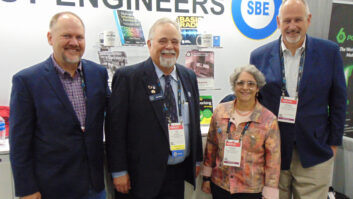(click thumbnail)Rich ChernockWith the complete shutdown of analog transmission now less than two years away, the annual Broadcast Engineering Conference (BEC) begins its seventh decade at NAB2007 with a full slate of activities.
What promises to be some of the timeliest technical sessions of the week will come in a couple half-day sessions Sunday, April 15.
The first Sunday session, aptly titled “February 2009,” 9:30 a.m.–1:30 p.m., is designed to provide an in-depth examination of the issues that broadcast engineers must consider by February 2009, when their analog transmitters are shut down for the final time.
Chaired by Wayne Kube, technology manager of broadcast media at Belo Corp., in Dallas, the meeting will address a wide range of issues, including consideration of an experimental ATSC-DTV single frequency network in Canada. Khalil Salehian, research engineer of Communications Research Centre Canada in Ottawa, will lead the discussion.
TOWER PREP
Another important part of the session will be the topic of planning for a station’s final DTV channel change, with presenter Dennis Wallace of Meintel, Sgrignoli & Wallace of Waldorf, Md. Wallace helped managed the RF lab testing for the Grand Alliance and served as systems engineer at the Advanced Television Test Center (ATTC) in Alexandria, Va.
“Tower crews will be at a premium and antenna change-outs may be the one factor that dictates your transition schedule,” Wallace said. “During the initial DTV build-out there were about 50 tower crews in the country equipped for the larger broadcast antenna jobs. Now we’re down to about 15 crews that are qualified and equipped for these large jobs. Thus, broadcasters need to plan now and get their tower work planned well ahead of the deadline. This may require that some antennas be changed out this spring, in cases where the analog antenna will be changed out for a new DTV antenna.”
Other expert “February 2009” presenters to discuss the final stages of the transition include James York of Dielectric Communications in Raymond, Maine; Srinath Ramaswamy of Triveni Digital of Princeton Junction, N.J.; and Myron Fanton of Electronics Research in Chandler, Ind.
IN THE NEWS
Immediately upon the session’s 1:30 p.m. conclusion, another timely session begins Sunday afternoon with a detailed four-hour series of presentations on the “Transition to HD News Production.” This event comes at a critical stage in the overall DTV transition as the number of broadcasters switching their local newscasts to 720p or 1080i is accelerating.
The session will continue until 5:30 p.m. and will be chaired by Dave Converse, vice president/director of engineering for the ABC/Disney TV Stations Group.
Monday offers an afternoon session from 1–5 p.m. titled “Broadcast Content – Ingest to Playout.” Featuring talks on networked storage, building a broadcast datacenter, workflow systems from sales to playout, the session is chaired by Lewis Zager, director, PBS DTV Strategic Services Group of Arlington, Va.
An all-morning session on Tuesday, April 17, 9 a.m.–noon, will delve into “Media Asset Management for TV,” chaired by Alan Popkin, director of engineering at KLS-TV/DT in Los Angeles, and will include expert technical presenters from Germany, Canada and the United States.
On Wednesday, April 18, repurposing broadcast content for wireless and other new media will be the subject of “Mobile Reception of ATSC DTV Signals,” 2–3:30 p.m. Richard Chernock, director of technology at Triveni Digital, will lead a portion of the session titled “TV Broadcaster Connecting with the Mobile User.”
“Billions of dollars are being poured into the deployment of broadband broadcast networks, and this investment is expected to yield mobile TV revenues topping half a billion dollars by 2010,” Chernock said.
“By addressing applications such as delivery of content to automobiles, technologies including ATSC 8-VSB give local broadcasters the opportunity to launch additional revenue-generating services and position themselves within the mobile TV value chain,” he said. Chernock’s firm has already teamed up with General Motors to explore leveraging ATSC 8-VSB as a possible broadband connection between content and vehicles.
Because broadband broadcast applications are undergoing a period of enormous growth, Chernock said, it is enabling the emergence of new content delivery models and revenue opportunities.
“With an understanding of newly developed solutions for efficient pushing of content over [these applications], producers of valuable local content can establish cost-effective mixed-delivery models for distribution of content to the mobile user,” Chernock said. “We’ll explore [in Wednesday’s session] one such solution and how it enables conventional broadcasters to build on their current business models.”












